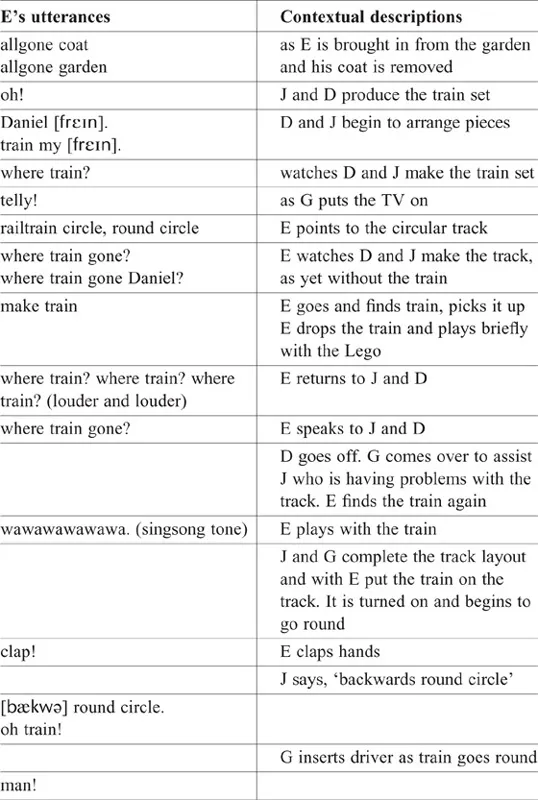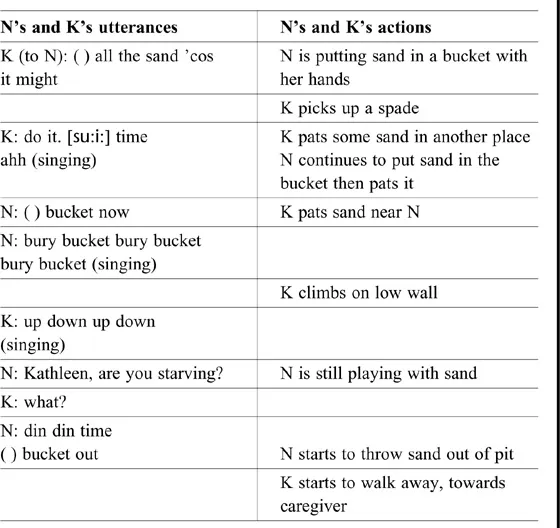
eBook - ePub
The Language of Children
Julia Gillen
This is a test
Buch teilen
- 112 Seiten
- English
- ePUB (handyfreundlich)
- Über iOS und Android verfügbar
eBook - ePub
The Language of Children
Julia Gillen
Angaben zum Buch
Buchvorschau
Inhaltsverzeichnis
Quellenangaben
Über dieses Buch
The Intertext series has been specifically designed to meet the needs of contemporary English Language Studies. Working with Texts: A Core Introduction to Language Analysis (second edition, 2001) is the foundation text, which is complemented by a range of 'satellite' titles. These provide students with hands-on practical experience of textual analysis through special topics and can be used individually or in conjunction with Working with Texts.
The Language of Children:
- introduces the key theories of language acquisition and provides a historical overview of the subject
- looks at all the ways children learn to communicate, from writing and talking to playing and using computers
- includes a wide variety of real texts and data, from records of childrens first words to children's hand-written stories and emails
- explores the language of children from a range of backgrounds and abilities, including deaf and bilingual children
- is user-friendly and accessible, and provides a full glossary.
Häufig gestellte Fragen
Wie kann ich mein Abo kündigen?
Gehe einfach zum Kontobereich in den Einstellungen und klicke auf „Abo kündigen“ – ganz einfach. Nachdem du gekündigt hast, bleibt deine Mitgliedschaft für den verbleibenden Abozeitraum, den du bereits bezahlt hast, aktiv. Mehr Informationen hier.
(Wie) Kann ich Bücher herunterladen?
Derzeit stehen all unsere auf Mobilgeräte reagierenden ePub-Bücher zum Download über die App zur Verfügung. Die meisten unserer PDFs stehen ebenfalls zum Download bereit; wir arbeiten daran, auch die übrigen PDFs zum Download anzubieten, bei denen dies aktuell noch nicht möglich ist. Weitere Informationen hier.
Welcher Unterschied besteht bei den Preisen zwischen den Aboplänen?
Mit beiden Aboplänen erhältst du vollen Zugang zur Bibliothek und allen Funktionen von Perlego. Die einzigen Unterschiede bestehen im Preis und dem Abozeitraum: Mit dem Jahresabo sparst du auf 12 Monate gerechnet im Vergleich zum Monatsabo rund 30 %.
Was ist Perlego?
Wir sind ein Online-Abodienst für Lehrbücher, bei dem du für weniger als den Preis eines einzelnen Buches pro Monat Zugang zu einer ganzen Online-Bibliothek erhältst. Mit über 1 Million Büchern zu über 1.000 verschiedenen Themen haben wir bestimmt alles, was du brauchst! Weitere Informationen hier.
Unterstützt Perlego Text-zu-Sprache?
Achte auf das Symbol zum Vorlesen in deinem nächsten Buch, um zu sehen, ob du es dir auch anhören kannst. Bei diesem Tool wird dir Text laut vorgelesen, wobei der Text beim Vorlesen auch grafisch hervorgehoben wird. Du kannst das Vorlesen jederzeit anhalten, beschleunigen und verlangsamen. Weitere Informationen hier.
Ist The Language of Children als Online-PDF/ePub verfügbar?
Ja, du hast Zugang zu The Language of Children von Julia Gillen im PDF- und/oder ePub-Format sowie zu anderen beliebten Büchern aus Filología & Lingüística. Aus unserem Katalog stehen dir über 1 Million Bücher zur Verfügung.
Information
unit three
Play and talk
Play is recognised as one of the most important contexts for child language, indeed for all aspects of child development. Greta Fein, an authority on pretend play, argues that play is a fuzzy concept, covering a myriad of activities from rough-and-tumble to board games. It is also clear that both the forms of play and the importance attributed to them vary tremendously between cultures. Nevertheless many developmental psychologists, sociolinguists working with children and others have found play a fruitful arena for the investigation of child language.
TRANSCRIBING TALK
Before we look at some data in detail, it could be helpful to consider the issue of transcription: the system used to note down children’s speech. In Unit one it was adequate to use the conventions of ordinary written English or German to convey utterances made by Leon, Nadia and so on in order to support the analysis made. Language researchers often want to consider aspects of speech in more depth. For example someone studying intonation will need to indicate variations in pitch and tone in their transcript.
Child language researchers sometimes wish to take note of pronunciation, this being an area in which children often display variations in comparison to others around them. Particular sounds may be difficult for children to pronounce, then in turn their attempts to do so may be hard for those around them to interpret. If you have read the core text of this series, Working with Texts: A core introduction to language analysis, you will have encountered the IPA (International Phonetic Alphabet) symbols for English phonemes. This is used occasionally in the transcripts that follow in this book where you might particularly wish to take note of a child’s pronunciation. You will find a copy of the IPA symbols on p. 87 of this book. Punctuation is used sparingly, to denote prosody. In the transcriptions that follow a full stop denotes a falling tone at the end of a phrase, a question mark a ringing tone, an exclamation mark sudden loudness and/or emphasis and a comma a slight pause. In addition, occasional notes in round brackets are used to give initial information to assist interpretation of the utterance.
Another issue transcribers have to make decisions about is layout. In this book turn breaks are generally indicated by horizontal lines. Sociocultural researchers in child language believe it is normally useful, if not essential, to give some indication of the child’s actions while speaking. (This should not surprise you after reading Unit two.) In addition mention is often made of changes in the child’s environment, including the actions and speech of others that appear clearly to influence the child.
The most difficult decision of all is how much detail to give. Ultimately, this must depend upon what aspects of the child’s language are particularly governing the investigation.
LANGUAGE IN PLAY
Example 1: Emlyn
The following transcription of a family play event was made when Emlyn (E) aged 2’ 2” came in from the garden to play with his grandmother (J) and a much older cousin, Daniel (D). Later assisted by Grandpa (G), they constructed and played with a train set. This is a transcription of the first ten minutes.
Activity
Look at the transcript of the event shown in Text: Emlyn. What can you say about Emlyn’s communicative competencies? What does he appear to have learned in the first two years or so of his life?
Text: Emlyn
Transcription key: In the child utterance column square brackets [ ] enclose phonemic transcriptions and round brackets ( ) enclose additional information on marked features such as prosody, e.g. (song tone).

Commentary
You probably noticed that many of Emlyn’s utterances are short, often consisting of two words although some are more complex. He also makes one word exclamations or vocalisations that are noises accompanying actions, e.g. ‘clap!’ or ‘wawawawawawa’. The kind of vocalisations that he probably produced since infancy can still appear in appropriate contexts – note, for example, the ‘wawawawa’ sound while he plays, making something move. The utterance ‘railtrain circle, round circle’ appears to be two two-word utterances strung together, rather than a more syntactically complex structure that an older person would probably apply in this context. This is evidence that the two-word structure is very useful and dominant for him at this time. However, lengthier structures are appearing when he clearly has strong motivation to communicate. His first ‘where train’ doesn’t receive a response. His second question on this topic is ‘where train gone?’ and when that is still ignored he tries to elicit a response by directing the question to one interlocutor in particular – a tactic that often works in conversation but which unfortunately still fails this time.
This passage shows one example of immediate imitation: Emlyn attempts to copy J’s fairly complex and unusual phrase ‘backwards round circle’, achieving most of its sounds. Although this transcription is not a phonemic one, it indicates that most of the time E is using sounds in a very recognisable way. Although he initially uses a [fr] sound for [tr] to begin the word ‘train’, he quickly adjusts his pronunciation. Such adjustments are by no means always possible at this stage, but this example shows that there are occasions a child can spontaneously make modifications, even within a particular conversation. (NB: these modifications happen spontaneously; it is quite pointless to try to teach such pronunciation shifts.)
One interesting word Emlyn uses is ‘allgone’. It has been transcribed with that spelling because many English-speaking children appear to construct this as one useful word.
As with all these transcriptions, you may well have noted other points not included in the above analysis.
Example 2: Niamh and Kathleen
While on a caravan holiday in Ireland, Niamh (N), 2’ 11”, and Kathleen (K), 2’ 0”, are playing in a sandpit.
Activity
Look at Text: Niamh and Kathleen. To what extent do the girls communicate through language? Are their actions communicative in any way?
Text: Niamh and Kathleen
Transcription key: In the child utterance column square brackets [ ] enclose phonemic transcriptions and round brackets ( ) enclose additional information on marked features such as prosody e.g. (singing). Empty round brackets ( ) indicate short (less than four syllables long) indiscernible utterances.

Commentary
This episode is typical of many play events by children around the age of two. At first sight a casual observer might consider that they are not playing ‘together’ at all – they are not engaged in a joint, cooperative activity with the clear rules and roles that appear in games of many sorts. The influential psychologist Piaget wrote that children are essentially ‘egocentric’ at this age, that is, more occupied in constructing their own understandings than able to engage socially with others.
At the same time, it appears likely that the girls are very aware of one another and that their activities are linked – this is sometimes called ‘parallel’ play. You probably spotted that actions initiated by one appear to be taken up, although in a different form, by the other, for example patting sand or singing rather than speaking. There is, too, some attempt at directly communicative speech, especially Niamh’s question, ‘Kathleen, are you starving?’ It’s not clear whether Kathleen understands the question, although her walk away shortly afterwards might mean that she has.
Play is an important context for language and indeed other aspects of development for the young child. Play does not necessarily exist in the same ways across all cultures, but it seems likely that some form of play is both common and important to most young children in their development capacities to imagine and express themselves. If you have seen young children play, you have very likely realised that it appears important to their emotional wellbeing. Vygotsky wrote:
Play for a child is a serious game, just as it is for an adolescent, although, of course in a different sense of the word; serious play for a very young child means that he plays without separating the imaginary situation from the real one.
(1967: 17)
Activity
Make a list of some of the ways in which play continues into adolescence and adulthood.
Commentary...